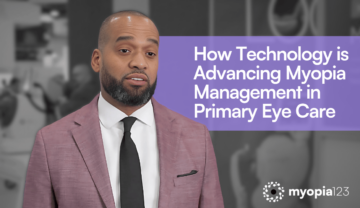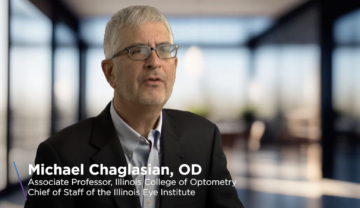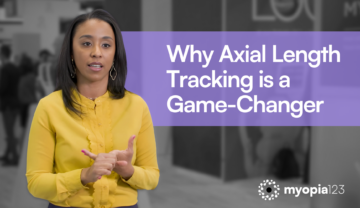Myopia Management Can Differentiate Your Practice
“Myopia management is not inexpensive, so having an objective measurement to show parents is helpful. They can see the axial length measurements on screen, and we can compare those measurements over time.”
Christopher Gee, OD, of Iron Horse Optometric Group in Dublin, California, has seen the myopia management section of his practice grow so considerably that is it now a branded clinic within the practice. “That has helped differentiate the practice, and patients come to the East Bay Myopia Clinic because they see us as experts,” Dr. Gee says.
As part of the myopia clinic and in exams with pediatric patients, the practice uses its Topcon MYAH to get an axial length measurement at every pediatric exam. “Patients and parents are used to hearing about nearsightedness, but educating them on axial length and how that measurement helps us provide the best care for their children positions us as experts.”
Vision Source® doctors are typically ahead of the curve in acquiring new technology, and Dr. Gee’s practice was eager to add the MYAH to their myopia clinic. MYAH is a versatile instrument that measures axial length and provides corneal topography, pupillometry, anterior cornea wavefront analysis, and contact lens fitting tools. The technology is impressive, and the data that comes with the testing can change a child’s life and minimize the risk of serious vision impairment.
Dr. Gee’s technicians acquire all of the MYAH scans and find the device very easy to use. They move the patient to the MYAH immediately after the autorefraction. “As long as the patient can sit reasonably still for about 20 seconds, we can get a good reading,” he says. “It’s so forgiving, and we are able to measure young children through about age 16 at their annual exams.”
Patients enrolled with the myopia clinic get axial length measurements every time they come in. It’s a critical part of parent education and keeping patients motivated.
“Myopia management is not inexpensive, so having an objective measurement to show parents is helpful. They can see the axial length measurements on screen, and we can compare those measurements over time.” For most young patients, one data point is not enough, which is one reason why Dr. Gee likes to screen even young children. That way, when the trend toward axial length elongation begins to surface, he can intervene more quickly.
He reminds patients and parents that he needs at least three data points to be able to show progress, too. “I can open the program on an exam room screen and show what the predicted rate of change might have been without intervention and where we are now, for example. But reminding patients that we need three data points also helps set their expectations for how quickly we will see results.”
Doctors measure refractive changes, too, but Dr. Gee feels that axial length measurements add a finer objective measurement to the process. And because the MYAH system is so reliable, technicians can capture these measurements without involving Dr. Gee. “I don’t necessarily need to see patients when they come in for these measurements. I review them later, and I text the parents the results of my analysis. It’s fast and convenient for everyone.”
He says that unless there are surprises in the results, he prefers to show parents the progression charts about once a year. It’s a little like stepping on the scale every day during a diet; the results may be so small in those short increments that it feels discouraging – even though the intervention may be performing well.
Earlier conversations and earlier intervention
Dr. Gee says that expanding the use of MYAH to capture axial length on all patients brought about an unexpected development. “I am talking about myopia much more than I used to. I initially thought we would scan every young patient, and I would look at the data and not mention myopia if the numbers were normal. But I’m finding myself having conversations about axial length elongation and why we measure it in the first place. Patients and parents like to hear their measurements are typical – and they like to know if and when there’s a detectable change,” he says.
As a result, he’s laying the groundwork for future myopia management patients when some patients are still very low myopes. “I wouldn’t have that conversation if I was basing it only on refractive error. But now, I’m collecting all the data on family history and refractive error and axial length, and we are having this important conversation sooner.”




